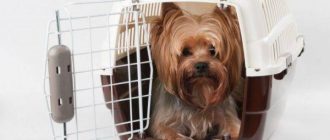As you know, proper nutrition and good digestion are the key pet health. Plays a major role in feed processing pancreas – a small “assistant” of the digestive tract. If she inflamed, animals develop a dangerous ailment – pancreatitis, a disease in which the process starts self-destruction of gland tissue. If normal digestive enzymes produced by the pancreas enter the duodenum, with pancreatitis, the release of enzymes does not occurs, and the fluid remains inside the gland itself, corroding it. IN In this article, we will find out what are the causes of pancreatitis in dogs, as well as how can you identify an ailment and help a faithful friend.
Why does pancreatitis develop
Contents
Pancreatitis in dogs does not appear from scratch, you can always find the cause of the disease. Most often, pancreatic inflammation glands in animals occurs in such cases:
- Feeding poor or inappropriate food (peppered, spicy, fatty foods, delay, flavorings, etc.), sharp change of diet;
- Poisoning by poisons and chemicals;
- Long-term use of medications (sulfonamides, diuretics, estrogens, etc.);
- Obesity;
- Serious diseases of the gastrointestinal tract (including the pancreas itself glands);
- Viral diseases, especially affecting digestive organs;
- Parasites;
- Trauma to the abdominal cavity;
- An excess of calcium;
- Diabetes;
- Hypothyroidism (or other endocrine diseases);
- Genetic predisposition.
It is believed that medium to old dogs are susceptible to pancreatitis. age regardless of gender. However, there are breeds of dogs which pancreatic disease is more common than others: poodles, miniature schnauzers, some types of terriers, boxers.
Symptoms of canine pancreatitis
Symptoms of pancreatitis in dogs depend on the form of the disease. In acute During the course of the symptoms of the disease are visible to the naked eye:
- Apathy, lack of interest in games, walks, treats
- Swelling and pain in the abdomen. At the slightest touch the dog begins to whine plaintively or hide;
- The unnaturalness of poses during rest and sleep (the dog tries shrink into a lump due to a sharp pain in the abdomen);
- Exhausting vomiting even after a few sips of water;
- Frequent heartbeat;
- Yellowness of the mucous membranes;
- Slight rise in temperature;
- Dyspnea;
- Diarrhea (against the background of an upset stomach and intestines in a dog dehydration often develops).
It should be noted that pain and other symptoms (diarrhea, tachycardia and etc.) in acute pancreatitis may not bother the dog constantly, and occur in the form of an attack from time to time. If a the animal cannot be helped in time, death is possible for example, from dehydration and cardiac arrest. So sharp an attack – an occasion to immediately contact a doctor. If acute pancreatitis was not promptly and conscientiously cured, inflammation can go into a chronic form. Then the symptoms are a little will change:
- Unhealthy appearance (dull and loose hair, all-weather molting, dry skin, thinness);
- Apathy and weakness;
- Poor appetite;
- Isolated cases of vomiting after eating;
- Problems with the stool (they can happen from time to time);
- The abdomen is tight, when you feel the animal feels noticeable discomfort.
Diagnosis of pancreatitis
At home, the diagnosis of pancreatic disease impossible. The fact is that unknowingly pancreatitis is easily confused with other ailments, for example, with viral hepatitis or helminthiasis. But without the correct diagnosis it will be impossible to save the dog. the specialist will not only listen to the owner and examine animal, but also conduct the necessary studies to identify pancreatic problems:
- Ultrasound, CT and an x-ray of the abdominal organs;
- Biopsy;
- Blood and urine tests;
- Duodenography (examination of the duodenum);
- Laparoscopy and gastroscopy of the pancreas.
Dog Pancreatitis Treatment
What to do if the pet has an attack of pancreatitis? Firstly, you need to provide peace to the dog. Any load (sports, training, running, long walks, etc.) only bring the pet tangible discomfort. Secondly, for a day the animal is better to free from food intake. If the dog asks eat, you can give her some mucous porridge (for example, oatmeal or barley), cooked in water. But in case of vomiting after taking the animal will have to drink food only during the day water. It is better to start the drug treatment of pancreatitis in dogs after a visit to the veterinary clinic, when the specialist will definitely establish diagnosis. However, if there is no opportunity to go to the veterinarian, doggie can be given pain medication (“Butorphanol”), an antiemetic (“Tserukal”) and antispasmodic (“Papaverine” or “No-Shpa”). If there is a decision was made to make pancreatitis treatment at home, and it will help the dog, to refuse everything from a visit to a specialist equally not worth it. The same pain medication will improve the condition of the animal, but will not fix the problem. It is likely that they will require infusion therapy (especially if vomiting is strong), antibiotics (with risk of infection), vitamins. Moreover, you may even need surgical intervention (for example, with an abscess pancreas). In other words, pancreatitis is not a disease that can not be treated. The most dangerous consequences of untreated inflammation can be called, for example, necrosis of gland tissue or the development of diabetes. In addition, self-medication can even harm the dog.
Feeding a dog with pancreatitis
We can not once again not mention the feeding of a patient with pancreatitis dogs. If in the first day after an attack of pain, the animal is kept on starvation ration or give a minimum of food, then in the future the pet is fed boiled meat and fish, cereals, mashed vegetables (from boiled pumpkin, carrots, zucchini), low-fat cottage cheese and kefir. Before serving the dog is warmed up to be a little warm. Reasonable instead habitual 2 times feed the dog up to 4-5 times a day small in portions. In order not to harm the animal, it is important not to enter the menu such products:
- Cabbage (any variety);
- Any raw vegetables or fruits;
- Corn;
- Greenery;
- Fatty meat and broths (pork, lamb);
- Sausages;
- Fat “milk” (including whole milk);
- Baked;
- Fried foods;
- Any spices;
- Sweets.
Pesikov, accustomed to purchased products, reasonably translate into special low-fat dog food for pancreatitis (“Hills Prescription Diet Canine W / D “,” Royal Canine Gastro Intestinal “or another that the doctor will recommend). It is important that the packaging food was marked “for dogs with gastrointestinal problems.” Diet with inclusion in the menu of medical feed lasts at least 2-3 weeks or more by agreement with the veterinarian. If the animal chronic pancreatitis, special feeds will become permanent a diet that will maintain the state of the pancreas up to the mark.






